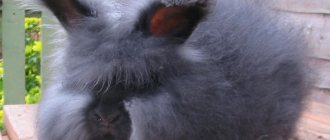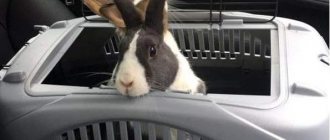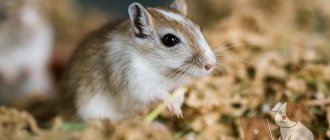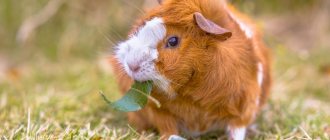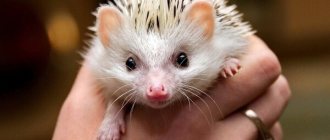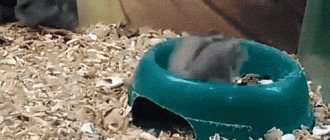A decorative rabbit is a more vulnerable and gentle pet than a cat or dog. It requires special care, which involves following certain rules. We'll talk about them today.
A properly cared for rabbit can live up to 12 years. He has beautiful soft fur that is a pleasure to touch. In addition, a rabbit in a good mood is a cheerful animal that happily participates in games. You have a wonderful incentive to care for your pet correctly!
general information
Decorative rabbits of various breeds were bred specifically for keeping at home. The birthplace of the first dwarf breed is considered to be Great Britain; it was there, in 1870, that the first “apartment” variety was bred.
Animal husbandry experts strongly recommend purchasing these cute furry animals from nursery breeders. You can also buy a decorative rabbit at a pet store, but in this case there is an increased risk that you will get an animal that is not entirely healthy. It's all about the conditions of detention, which in stores often leave much to be desired.
In general, there are about two hundred breeds of rabbits. They are classified according to the main characteristics:
| Sign | Characteristic |
| Wool length | Shorthair, normalhair, longhair |
| Body mass | Small, medium, large |
| Productivity (purpose) | Down, meat-skin, meat, decorative |
For pet lovers, decorative species are of greatest interest, which we will discuss in detail in the article.
In the photo - a dwarf rabbit of the ram breed - one of the most popular among pet lovers
Today, a large number of decorative breeds have been bred, for example, ram, lion's head and many others, from which you can choose a cute pet with an unusual appearance or calm character. If you are determined to get such a pet, do not rush to go to the nursery. Before you bring your little animal home, take care in advance of the place where it will live - buy a cage and all the necessary equipment for it.
Popular breeds
Today, about two hundred decorative breeds of rabbits have been bred. They mainly differ in the following characteristics:
- By weight and size: large, medium and miniature.
- By coat length: with medium coat length, long-haired, short-haired and mixed, i.e., individual areas of the body have fur of different lengths.
- By color: one-color, two-color, three-color. More than 60 types of colors are known.
- According to the fit and shape of the ears. Ears can be short, long, wide. They may stick up or hang down the sides of the head.
The main criteria for popular breeds can be found in the table.
| Breed name | Weight, kg | How long do they live, years | Wool length | Ears, cm | Color | Character |
| Dutch dwarf | 1,7 | 7 | average | 5-7.5 erect | plain: grey, black, blue or tortoiseshell | active, mobile |
| Dutch Fold | 1,7 | 7 | average | 25 hanging | plain, two-color | friendly, affectionate, easy to train |
| Dwarf ram | 2 | 6-7 | short | 28 hanging | plain, two-color | calm, good-natured |
| Dwarf butterfly | 1,8 | 7 | short | 8 erect | black and white | calm, friendly |
| Rex | 1,7 | 6 | short | 7 erect | plain, two-color | calm |
| Hermelin | 1,5 | 8-12 | short | 5 erect | white | sociable, active, affectionate |
| Angora dwarf | 1,7 | 5-7 | long | 4-5 erect | plain: white, red, gray, two-color: gray with white, red with gray | sociable, calm |
| Angora lion | 1,6 | 9 | long | 5-6 erect | white, brown, red | sociable, affectionate |
| Lion head | 1,7 | 7 | short on the body, long on the head | 8-9 erect | blue, opal, chinchilla, sable | timid, active |
What should a cage be like for a decorative rabbit?
When choosing a suitable home for your future furry pet, adhere to the rule “more is better than less.” Naturally, within reasonable limits. The size of the cage should be at least 4 times larger than the baby rabbit itself. These animals grow quite quickly, and it is important that they have enough space. If an adult rabbit cannot lie down the full length of its body, then the cage is too small for it. The animal must also be able to stand on its hind legs and stretch upward. If the height of the cage does not allow him to do this, think about purchasing a more spacious living space for your pet. In addition, it is necessary to provide the possibility of placing:
- hay manger;
- automatic drinker;
- house (preferably, but not required).
You should immediately acquire a carrier cage for transporting your furry pet.
It is better to secure all accessories to the bars of the cage, thereby saving space for the animal. The structure must be equipped with a plastic tray. Never buy a product with a mesh floor. The paws of decorative rabbits are not suitable for walking on such a surface, and therefore can be injured.
The following video will tell you how to prepare the cage before the rabbit appears:
General content tips
Below we will look at the most important information regarding keeping dwarf rabbits at home.
Temperature
Decorative rabbits are very sensitive to heat. If the air in the room where the cage is located is heated to 25 ℃ or higher, the animal may suffer heatstroke . The cage should not be located in a place exposed to direct sunlight, otherwise your pet will also be at risk of overheating. In addition, the animals are “afraid” of too high air humidity (above 60%) and drafts. They feel best at a temperature of 18-21 ℃ and a humidity of 40-50%.
Let us note one more interesting nuance. Decorative rabbits do not have sweat glands, and their long ears are responsible for heat exchange in the body. If your pet is hot, you can always help him cool down a little. To do this, gently wipe the ears with a soft, clean cloth soaked in cool water. Some rabbit breeders put a plastic bottle of frozen water in the cage, install mini-pools, and periodically spray or bathe the animals.
The ears of representatives of decorative breeds are not large enough to prevent them from overheating and possible heat stroke
Precautionary measures
Owners of dwarf rabbits should be aware that these animals have a rather fragile spine and it is important to ensure that the animal does not jump from great heights. The rabbit must be held firmly when it is in your hands. Some individuals try to open the cage door on their own, so it is better not to place the “dwelling” high from the floor.
To prevent the rabbit from getting injured while walking around the apartment and causing damage to your property, the animal must be constantly supervised, isolated from other pets (cats, dogs), and controlled communication with small children who are very curious and can harm the animal by dropping or grabbing it. him behind a vulnerable spot, for example, behind the ears.
Try to protect your furry pet from loud noise and harsh sounds. Being in a constant state of stress, the animal can get sick and even die.
Decorative rabbits are quite smart. They are able to respond to their name and willingly go into the arms of people to whom they get used. These animals like to be stroked on the head and back, but it is better to avoid contact with the animal’s chin.
Rabbits are active in the evening and at night, and during the day, as a rule, they rest
Hygiene
Decorative rabbits are clean animals and independently clean their fur from dirt. Bathing them is not recommended, but it is acceptable if the animal has an upset stomach. Once you decide on this procedure, make sure that water does not get into your pet’s ears. After bathing, try to dry it immediately and protect it from drafts.
A layer of sawdust or straw must be placed on the bottom of the cage (you must ensure that it is dry at all times). Complete replacement of litter should be carried out at least once every 2 weeks. The tray should be washed every day, otherwise the fluffy will start going to the toilet in different parts of the cage, which will lead to an unpleasant odor.
Don't forget to trim your pet's nails periodically to prevent him from injuring himself. To carry out this procedure, it is better to use special nail clippers.
Nails need to be trimmed at least once every 3 weeks.
Rabbits quite often eat the products of their vital activity, which is called coprophagia (there is no need to worry about this - this is an absolutely normal phenomenon). They have two types of feces: hard, dry pellets and soft droppings. It is the latter that the animals eat, since it is not completely digested food (not fully digested succulent and roughage). It is soft feces that contain a huge amount of amino acids, vitamins and nitrogenous substances that are important for the animal.
Coprophagia in dwarf rabbits is explained by the peculiarities of their digestive system. During the first cycle of food digestion, the animal cannot get everything valuable and useful from it, so it starts this process in the second round.
Walks
Decorative rabbits need movement. As a rule, there is very little space in the cage, so the animals must be let out for walks around the apartment. Preferably daily.
Your pet should not be left unattended. He can get scared and hide in any crevice or corner. In addition, each animal has its own instincts. In rabbits, they manifest themselves in the form of a desire to gnaw on everything that comes along the way. This could be shoes, wires, and so on.
A spacious enclosure will allow pets not only to have fun, but will also help keep the owners’ belongings safe
If you want to raise an affectionate animal, you should periodically pick it up (it is better to do this while sitting for the pet’s safety), stroke it, communicate with it and call it by name. The animal should get used to you. This will take some time, but in the end you will raise a fluffy who will respond to his name and willingly go into your arms.
Nutrition
The main product in the diet of a decorative rabbit is hay. You should choose it carefully: it should be dry, pleasant in smell, and free of mold. Don't forget to regularly fill the manger with hay. Furry pets also love various grain and succulent foods. The bowl for such food should be heavy so that the animal does not throw it around the cage.
High-quality hay must be present in the daily diet
Make sure your animal always has water . It is best to use an automatic drinker as a container for it. Rabbits can be given regular tap water, having first settled it or passed it through a special filter. It is strictly forbidden to give your pet mineral water, as it usually contains a large amount of salts, which provokes the occurrence of urolithiasis in all breeds of decorative rabbits.
The animal must be provided with the necessary vitamins and microelements . You can purchase special foods and supplements at pet stores. To ensure a balanced diet for rabbits, fresh or dried fruits (apples and pears) and carrots are introduced into their diet. Rabbits also eat cabbage with great pleasure, but it should be offered in small quantities. It is also recommended that these animals be given twigs of apple, birch, currant, rowan and pear to chew on.
Grooming
It is necessary to introduce a rabbit to grooming during childhood. This will make it easier for your pet to get used to the procedure and begin to enjoy it completely. After all, this is such a chance to get the owner’s attention - and a favorite treat, of course!
How to comb a rabbit?
- Provide a calm environment so that other people or animals, as well as loud noises, do not frighten your baby.
- Approach the rabbit, talk calmly to it and stroke its forehead (such actions will calm the pet, and it will be able to trust you).
- Take your baby in your arms and place him on a table or other stable, non-slip surface.
- Take a comb and begin to gently comb your pet in the direction of hair growth, while continuing to talk to him calmly.
- It is advisable to use a special spray to facilitate combing so that the coat is obedient, does not become tangled or damaged.
- Gently comb your friend starting from the back and gradually moving to the sides.
- Sit on a chair and place the rabbit on your lap, paws up. Ask an assistant to comb the baby's tummy, groin area, tail and armpits (over time, the pet will get used to such procedures and the need for an assistant will disappear).
Decorative rabbits are naturally very clean, and they are excellent at caring for their coats. If the owner properly cares for the rabbit and regularly cleans the cage, if the rabbit is healthy, then its fur looks well-groomed. If the baby does get dirty, try to remove the dirt locally: using a damp brush or napkin.
Remember that rabbits should only be bathed as a last resort. For example, if the fur is very dirty or if the rabbit has parasites. Bathing in itself is a huge stress for a rodent. In addition, during washing, the sweat-fat layer is washed off and the functioning of the sebaceous glands is disrupted - hence dermatological problems.
If you do plan to give your pet a bath, use a shampoo specifically formulated for rabbits.
Common diseases
Decorative dwarf rabbits are fragile and delicate creatures, susceptible to stress and a large number of diseases. However, with proper care and timely contact with a veterinarian, almost any ailment can be treated.
Owners need to be careful and alert if:
- the animal hides, hides in a corner and other places unusual for it;
- the coat looks disheveled and dull and begins to shed;
- appetite worsens;
- there is diarrhea or constipation;
- discharge appears from the eyes or nose.
At the first alarming symptoms, it is better not to self-treat, but to immediately show your pet to a veterinarian
Stomach upset
The most vulnerable part of a rabbit’s body is the stomach. Therefore, any disturbances in the animal’s diet can lead to digestive disorders, primarily diarrhea.
Stomach upset is most often caused by:
- eating moldy bread or dry food;
- entering the diet of food affected by pests, for example, weevils;
- sudden change in diet;
- eating excess amounts of vegetables and fruits;
- viral infections;
- pathologies of the digestive system;
- unsanitary conditions in the cage.
As first aid for diarrhea, you can do the following:
- Give the animal a chamomile solution prepared according to the instructions. Dilute the resulting product at the rate of 0.5 tbsp. l. decoction for 1 tbsp. l. water and give three times a day for a week. If the rabbit refuses to drink on its own, you can forcefully pour the product into the mouth using a syringe without a needle.
- Clean and disinfect the cage well. Lay down new bedding.
- Remove all food, vegetables and fruits from the diet, feed only hay and give water.
If the diarrhea does not go away within one or two days, you should immediately consult a veterinarian.
Paralysis
Paralysis often affects the hind limbs and lower spine. The rabbit becomes inactive and lies on its side. This condition leads to constipation and poses a high risk to the life of the animal.
It is known that the disease is easier to prevent than to treat. For the purpose of prevention, it is necessary to ensure that the rabbit does not jump from a height (sofa, table and other furniture), and also does not slip on a smooth surface. In addition to traumatic causes, paralysis can be caused by a lack of vitamins and microelements, as well as infectious diseases. At the first symptoms of the disease, you should consult a specialist.
Rhinitis
As mentioned above, rabbits are very sensitive to drafts and do not tolerate unfavorable environmental conditions. Due to decreased immunity, bacteria develop in animals' bodies, causing runny noses and sneezing. Long-term illness leads to profuse discharge from the eyes and nose, weight loss, and loss of shine in the coat.
From the following video you can learn how and with what to treat a runny nose in rabbits:
Reproduction
For most owners, the issue of breeding decorative rabbits is not relevant. It is enough that one pet lives at home.
When choosing the sex of an animal, you should take into account that males are more aggressive and impulsive than females. The urine of males has a very unpleasant odor, especially noticeable when they exhibit the instinct to mark territory. To exclude the latter, it is necessary to take care of timely castration .
Rabbits are known for their fertility. Therefore, if you decide to breed animals, with proper care you can get up to 8 litters per year. As a rule, representatives of decorative and dwarf breeds are able to become parents from 6-7 months of age. Pregnancy lasts 31 days. During this period, caring for the rabbit does not change much, but the diet should be diversified by adding foods rich in vitamins to the diet.
How long do dwarf rabbits live at home?
With proper care, good nutrition, and sufficient physical activity, decorative rabbits live 8-9 years, and some long-livers up to 11-12.
If pets are not intended to be bred, the rabbits are neutered. This adds several extra years to their life.
Cute furry pets can lift your spirits and add new colors to life. By caring for rabbits, children become more responsible, and adults forget about their problems. Good-natured, affectionate animals do not require large expenses or special care; they sincerely pay their owner with affection and love.
Maintenance at the dacha
With the onset of spring, many owners begin to travel outside the city to their dachas. Before taking your pet with you on a trip, carefully weigh the pros and cons. Remember that rabbits are not only cute in appearance, but also extremely gentle animals. Therefore, it is not recommended to transport them from place to place unless absolutely necessary. They do not tolerate stuffiness and heat well, and air conditioning can cause colds. Stress will also have a detrimental effect on your pet’s well-being. Therefore, if your stay at the dacha is short (up to five days), it is better to leave the rabbit at home.
When keeping a pet at your dacha, take care to protect it from other animals.
Being in nature is fraught with many dangers, so you should adhere to the following recommendations:
- limit contact of the fluffy with other animals, for example, dogs, cats, birds;
- make sure that your pet does not dig up and eat the roots of plants, for example, tulips, daffodils or peonies, that contain substances that are toxic to him;
- install a portable enclosure, placing it in the shade and covering it with netting.
Games and entertainment
It is necessary not only to periodically let rabbits out of the cage to walk around the apartment, but also to offer them games. An animal left unattended can not only chew furniture and wallpaper, but also cause harm to itself, for example, by biting wires. Therefore, take care of entertainment in advance in the form of:
- special toys that are sold in pet stores and are intended for dogs and cats (rubber bone, ball with a bell, etc.);
- a running ring installed in a cage;
- a walking ball for traveling around the apartment;
- cardboard box with cut-out entrances and exits;
- paper cylinders left over from using toilet paper.
Domestic rabbits are willing to be handled and love to be stroked and scratched.
Another option is to build a special enclosure for walking, where the animal will be provided not only with space, but also with safety.
Reviews
Nadezhda, 33 years old, Moscow
Dwarf rabbits are a real miracle! They are very cute and pretty. Many people write that these animals can be trained, but I couldn’t. My little rabbit turned out to be wayward and goes about his business on walks, completely ignoring my attempts to tame him.
Anna, 20 years old, Ekaterinburg
We organized a cage for our decorative little lamb according to all the rules: we selected a spacious room, attached a hay holder, a special drinking bowl, a bowl, and even equipped a toilet. But the animal did not want to use it carefully; after 5 minutes the hay was scattered, the bowl was turned over, and he began to chew on the tray. I wonder if it was me who was so violent or if everyone is like this?
Marina, 41 years old, Omsk
I spent a long time choosing the breed of my future pet. I weighed all the pros and cons, comparing the conditions of detention, the appearance and character of the animals. In the end, I chose the Hermelins, and did not regret it. A very smart animal, it recognizes its owners and even responds to its name. At the same time playful and very cute! She enjoys sitting in her daughter's arms.
Purpose
As can be understood from the above, a rabbit is not an animal that urgently needs a lot of free space. For this reason, many breeders prefer to save space and house the animals as densely as possible. Of course, there are special situations. For example, small rabbits cannot be immediately separated from their mother, and a standard cage cannot accommodate a whole family for one rabbit. For this reason, rabbit cages are divided into several types according to their purpose. If you are serious about breeding, then it is worth having all these types of rabbit homes.
For breeding
In general, such cages can be called standard, because they are intended for fattening and permanent residence of rabbits. Feeding houses can be single-tiered or multi-tiered; they can be located both indoors and outdoors, but taking into account the necessary insulation. Feeders are often built into the doors of such cages, which allows you to give your pet food without opening the door - this greatly reduces the chances of escape.
Breeding cages are often placed in one housing: two per tier. The partition between them can be easily removed - this is necessary to bring together a rabbit couple for which the time has come to reproduce. Since no transplant is necessary, the animal does not experience additional stress and does not have the opportunity to escape.
For the litter
Cages for uterine rabbits require special conditions of detention, if, of course, the owner is concerned about obtaining live and healthy offspring. Unlike the rest of her life, during pregnancy the female is no longer so unpretentious to her environment - it is advisable to provide an environment similar to what it would be in a natural habitat.
The maternity cage is always located inside the utility room, and additional heating is also assumed - this is done using a heating cable or an ordinary light bulb. In this case, the cage should be located near a wall with no windows - it is assumed that the female is in a hole, which means it is relatively warm and dark there. When preparing for childbirth, nothing should tell the rabbit about danger, so the nesting cage should be located in a quiet and peaceful place.
For young animals
Unlike adult rabbits, it is more practical to keep young rabbits together - at least until they outgrow their common cage and become interested in procreation. Consequently, a cage for young animals is the only group housing option, except for an enclosure, where young animals end up from about three months of age.
It is assumed that one cage can contain from 8 to 20 individuals, while each young rabbit should have at least 0.15 square meters of area. Such rabbit cages are made quite high: their ceiling should be at least 35 cm high. Young animals are especially tasty prey for predators, including domestic cats, so in outdoor conditions their home is placed at a height of at least 70 cm from ground level.
For the breed "giants"
Those who breed rabbits for meat highlight only one drawback of these animals - they are quite small. Naturally, breeders have long thought about this problem and have already managed to develop several breeds, among which two can be distinguished: Californian and “giant”. Representatives of both breeds are distinguished by good sizes - “Californians” have an average length of 45-50 cm and a weight of up to 5 kg, and “giants” are absolutely huge - 55-65 cm in length, while weighing from 5.5 to 7. 5 kg. Naturally, both breeds require much larger cages in all cases.
For example, for an ordinary single cage intended for a Californian breed rabbit, the normal size is an area of 0.5 square meters. In the case of a “giant”, the dimensions of the housing can be even more impressive - the minimum requirements are dimensions of 120x80x60 cm.
In one litter, such rabbits produce up to 8 rabbits, and although the number does not seem too large compared to ordinary relatives, the size of the babies also requires an increase in living space to at least 1.2 square meters with a height of 40 cm. Since the animals are of significant weight, the cages for such rabbits of any age, they are usually additionally reinforced with sheet metal.

